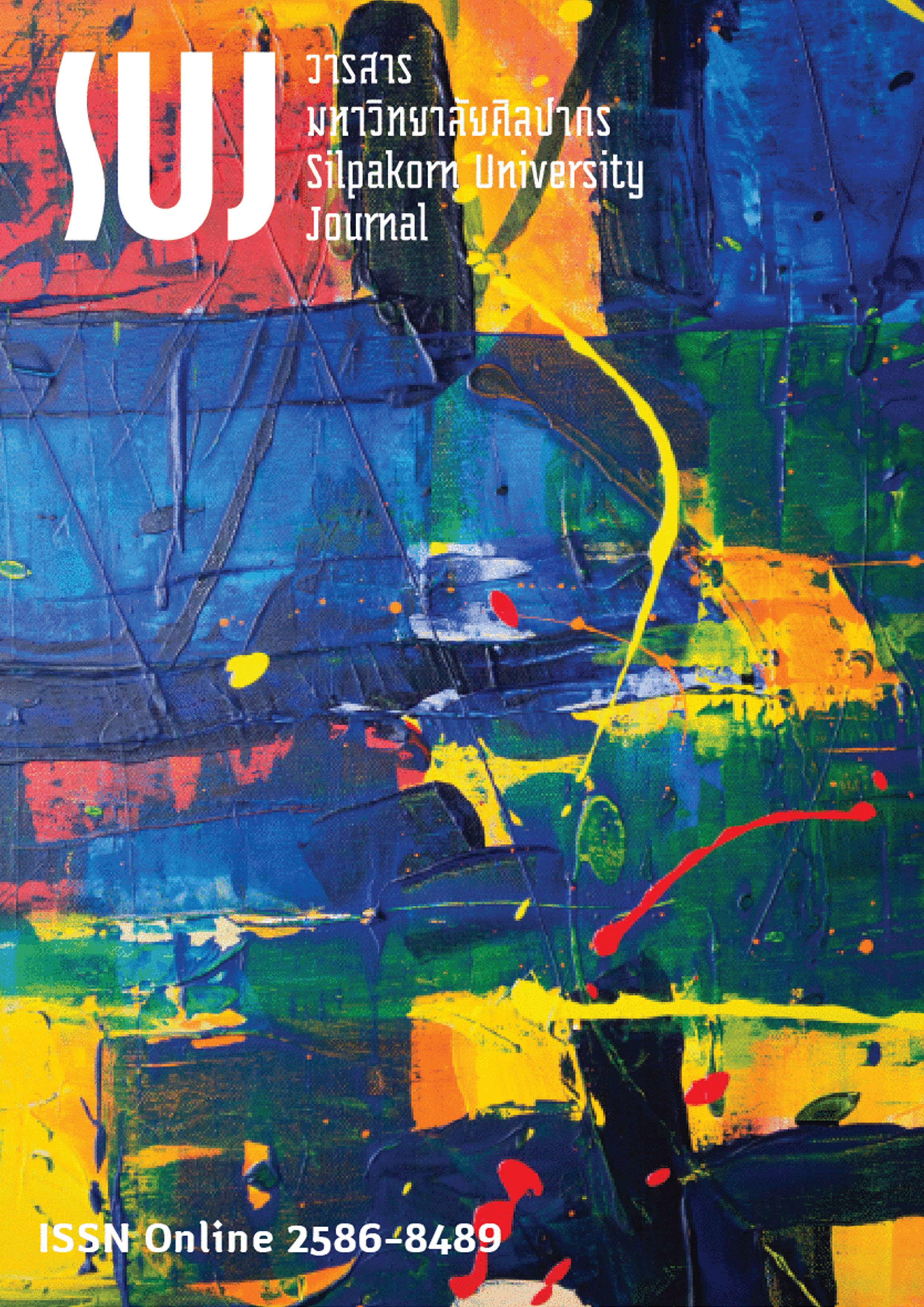การพัฒนาสื่อการเรียนรู้เพื่อส่งเสริมกระบวนการคิดเชิงสร้างสรรค์ในการสร้างสื่อยุคดิจิทัลร่วมกับเทคโนโลยีความเป็นจริงเสริม (AR) (The development of instructional media to promote creativity in the creation of digital media with augmented reality technology)
Main Article Content
Abstract
การวิจัยครั้งนี้มีวัตถุประสงค์เพื่อ 1) ศึกษากระบวนการคิดเชิงสร้างสรรค์ในการสร้างสื่อยุคดิจิทัล 2) พัฒนาสื่อการเรียนรู้ เรื่องกระบวนการคิดสร้างสรรค์ในการสร้างสื่อยุคดิจิทัลร่วมกับเทคโนโลยีความเป็นจริงเสริม 3) เปรียบเทียบความคิดสร้างสรรค์ในการสร้างสื่อยุคดิจิทัลของผู้เรียนก่อน-หลังการเรียนรู้ และ 4) ประเมินความพึงพอใจของผู้เรียนที่มีต่อสื่อการเรียนรู้ โดยระเบียบวิธีวิจัยเริ่มจากการศึกษากระบวนการคิดเชิงสร้างสรรค์ในการสร้างสื่อยุคดิจิทัลจากการสัมภาษณ์ผู้เชี่ยวชาญด้านสื่อยุคดิจิทัล นำข้อมูลมาพัฒนาเป็นสื่อการเรียนรู้ ประเมินความคิดสร้างสรรค์ก่อน-หลังการใช้สื่อการเรียนรู้ และประเมินความพึงพอใจของผู้เรียน โดยกลุ่มตัวอย่างเป็นนักศึกษาคณะเทคโนโลยีสื่อสารมวลชน จำนวน 128 คน ผลการวิจัยพบว่าองค์ประกอบของกระบวนการคิดเชิงสร้างสรรค์ในการสร้างสื่อยุคดิจิทัลที่ผู้เรียนจำเป็นจะต้องรู้ ประกอบด้วย 1) การเปลี่ยนแปลงของกระบวนการสร้างสรรค์สื่อในยุคดิจิทัล 2) วิธีการคิดสร้างสรรค์สื่อในยุคดิจิทัล 3) กระบวนการคิดสร้างสรรค์สื่อในยุคดิจิทัล และ 4) การพัฒนาความคิดสร้างสรรค์ในการสร้างสื่อในยุคดิจิทัล และผลการเปรียบเทียบคะแนนความคิดสร้างสรรค์ของกลุ่มตัวอย่าง โดยใช้การทดสอบค่า T-test แบบ Dependent samples มีคะแนนเฉลี่ยรวมหลังเรียน (25.59) สูงกว่าก่อนเรียน (13.58) อย่างมีนัยสำคัญทางสถิติที่ระดับ .01 และผลประเมินความพึงพอใจของผู้เรียนที่มีต่อสื่อการเรียนรู้ อยู่ในระดับพึงพอใจมาก (ค่าเฉลี่ยเท่ากับ 4.29, S.D.=.610) ซึ่งจากผลการวิจัยจะเห็นได้ว่าสื่อการเรียนรู้ สามารถส่งเสริมให้ผู้เรียนเข้าใจกระบวนการคิดสร้างสรรค์สื่อได้เป็นอย่างดี และกระตุ้นให้ผู้เรียนมีระดับความคิดสร้างสรรค์มากขึ้นอีกด้วย โดยสามารถนำไปประยุกต์ใช้ในการเรียนการสอนวิชาความคิดสร้างสรรค์ ซึ่งเป็นทักษะพื้นฐานสำคัญในการทำงานด้านสื่อสารมวลชน งานออกแบบ และงานที่เกี่ยวข้องในแขนงต่าง ๆ
This research aimed 1) to study creative thinking processes in media creation in the Digital Age, 2) to develop instructional media regarding the creative thinking processes in media creation in the Digital Age together with the augmented reality technology, 3) to compare learners’ creativity through before-after learning process of media creation in the Digital Age, and 4) to evaluate satisfaction of the learners. This study was conducted by examining the creative thinking processes in a process to create media in the Digital Age by means of an interview with the experts who specialized in the media in the Digital Age. The result was analyzed and applied to develop learning media which were associated with the creative thinking processes in creating media in the Digital Age, along with the augmented reality technology. The creativity was evaluated before and after the application of the learning media. Then measure students’ satisfaction. There were 128 samples who were the students in the Faculty of Mass Media Technology. The findings revealed that the components of the creative thinking processes in media creation in the Digital Age included 1) variation of the media creation processes in the Digital Age, 2) creative thinking skills for media creation in the Digital Age, 3) different thinking processes of media creation in the Digital Age and, 4) creativity development for media creation in the Digital Age. The comparative result of creativity score of the samples by dependent t-test indicated that the mean score after classes was 25.59 which was higher than before classes at 13.58 with statistical significance at .01. In addition, student satisfactory resulted in the high level at 4.29 (S.D.= 0.610). The findings show that learning materials can encourage students to understand media creative process better and encourage them to have a more creative level. It can be applied to teaching creativity, which is a fundamental skill in journalism, design and related work.
Downloads
Article Details

This work is licensed under a Creative Commons Attribution-NonCommercial-NoDerivatives 4.0 International License.
References
Bangkok University. (2019). Ready for the digital world creative learning think ahead of the future (พร้อมรับมือโลกดิจิทัล เรียนรู้แบบสร้างสรรค์ คิดล้ำนำอนาคต). [Online]. Retrieved January 25, 2020 from https://www.bu.ac.th/th/bu-magazine/view/335
Chalarak, Nawaporn. (2015). The Teacher’s Role and Instruction in The 21st Century (บทบาทของครูกับการเรียนการสอนในศตวรรษที่ 21). FEU Academic Review, 9(1): 64-71.
ISRA Institute Thai Press Development Foundation. (2019). Guidelines for curriculum development in mass communication for Media Disruption and AI (แนวทางการพัฒนาหลักสูตรด้านสื่อสารมวลชนเพื่อรับมือกับ Media Disruption และ AI). [Online]. Retrieved January 25, 2020 from https://www.isranews.org/content-page/item/76429-isra-76429.html
Kaul, Vineet. (2012). The Changing World of Media & Communication. Mass Communication & Journalism, 2(6): 1-5.
Lertpradit, Jittipong. (2021). Marketing Technology Trend 2021 (พลิกโลกการตลาดด้วยมาร์เทค). Nonthaburi: IDC Publishing.
Majid, N. A. A., Mohammed, H., & Sulaiman, R. (2015). Students’ Perception of Mobile Augmented Reality Applications in Learning Computer Organization. Procedia - Social and Behavioral Sciences, 176: 111-116.
Marketingoops. (2020). Insights Millennials use apps from Mass to Me (Insights คนมิลเลนเนียลใช้แอปฯ จาก Mass สู่ Me มีสื่อโซเชียล 10 แอป/คน ต่างแพลตฟอร์ม ต่างพฤติกรรม). [Online]. Retrieved February 17, 2020 from https://www.marketingoops.com/reports/behaviors/5-consumer-behaviors-digital-platform/
Morgan, N. (2013). How Digital Technology Has Changed Communication - First Of Three Posts. [Online]. Retrieved February 13, 2020 from http://www.forbes.com/sites/nickmorgan/2013/05/21/how-digital-technology-has-changed-communication-first-of-three-posts/
Nivitanont, Pitchaya. (2014). Guidelines on Advertising Execution in Digital Media (แนวทางการคิดสร้างสรรค์โฆษณาในสื่อดิจิทัล). Journal of Communication and Management NIDA, 1(2): 21-36.
Promyen, Rames. (2017). TK park drives the concept. “Learning in Digital Age” towards sustainable social and economic development (TK park ขับเคลื่อนแนวคิด “การเรียนรู้ในยุคดิจิทัล” สู่การพัฒนาสังคมและเศรษฐกิจอย่างยั่งยืน). [Online]. Retrieved February 3, 2020 from https://www.youtube.com/watch?v=4eyXibQ_J88
Sarkar, P., Kadam, K., & Pillai J. S. (2020). Learners’ Approaches, Motivation and Patterns of Problem-Solving on Lines and Angles in Geometry Using Augmented Reality. Journal of Smart Learning Environments, 7: 17.
Serio, A. D., Ibáñez, M. B., & Kloos C. D. (2013). Impact of an Augmented Reality System on Students’ Motivation for a Visual Art Course. Journal of Computers & Education, 68: 586-396.
Sinlarat, Paitoon. (2014). Skills of the 21st Century: Stepping Away from the Trap of the West (ทักษะแห่งศตวรรษที่ 21 : ต้องก้าวให้พ้นกับดักของตะวันตก). Bangkok: Chulalongkorn University.
Smith, R. (2013). What is Digital Media? [Online]. Retrieved February 3, 2020 from http://thecdm.ca/news/faculty-news/2013/10/15/what-is-digital-media
Sriritthipradit, Swarit. (2020). Customer Insight? (Customer Insight คืออะไร พร้อมวิธีหา Insight ในยุค Data & Martech). [Online]. Retrieved March 23, 2021 from https://contentshifu.com/blog/what-is-customer-insight
Winijchakul, Wattanachai. (2014). The compound in thinking about learning (รวมมิตร คิด เรื่อง การเรียนรู้). Bangkok: TK Park.
Wongyai W., & Patphol M. (2019). Management of Learning in The Era of Disruptive Innovation (การจัดการเรียนรู้ในยุค Disruptive Innovation). [Online]. Retrieved January 20, 2020 from https://issuu.com/tlcspu/docs/disruptive_innovation_1544646601
Yilmaz, R. M., & Goktas, Y. (2016). Using Augmented Reality Technology in Storytelling Activities: Examining Elementary Students’ Narrative Skill and Creativity. Journal of Virtual Reality, 21(2): 75-89.


